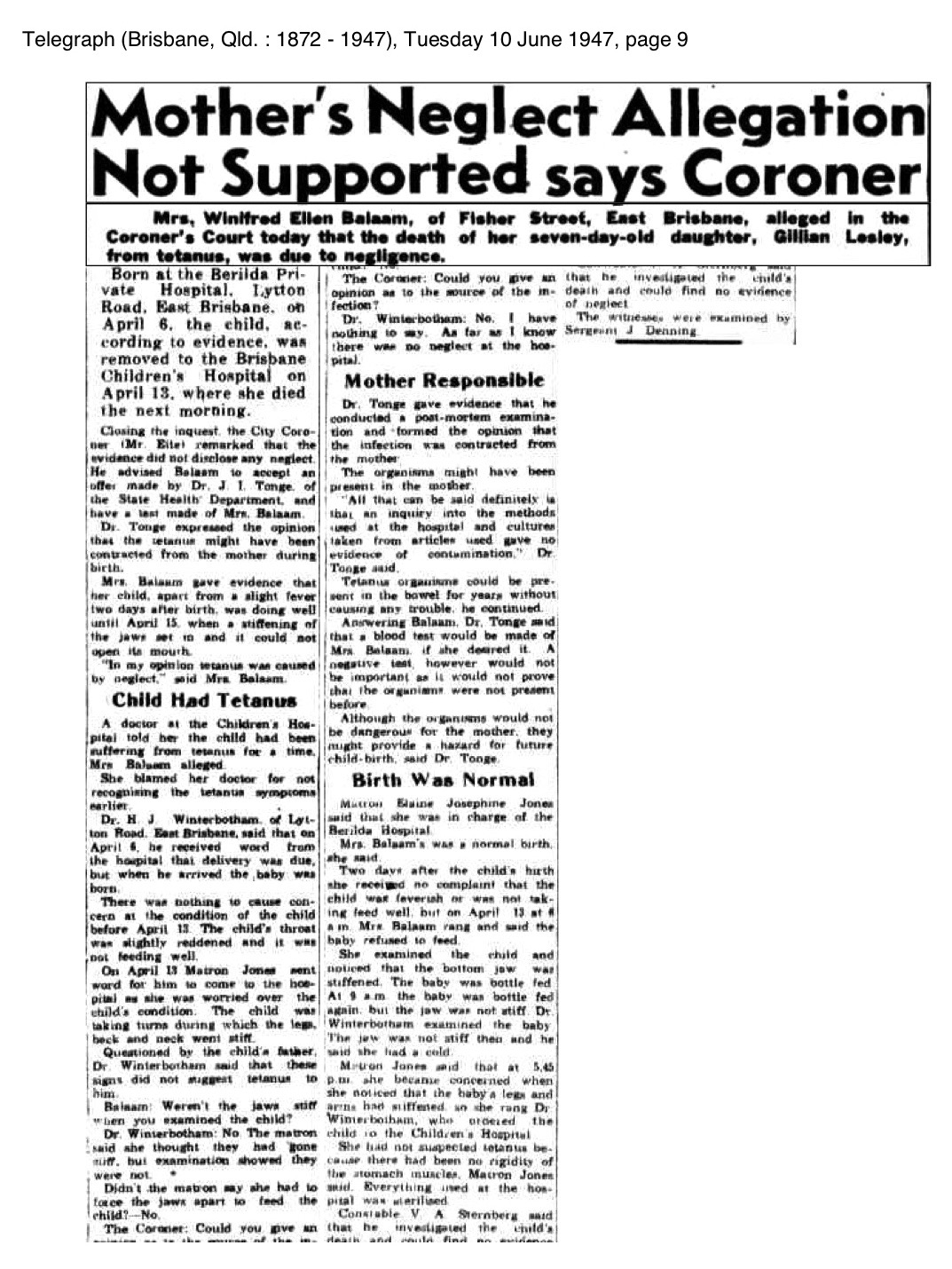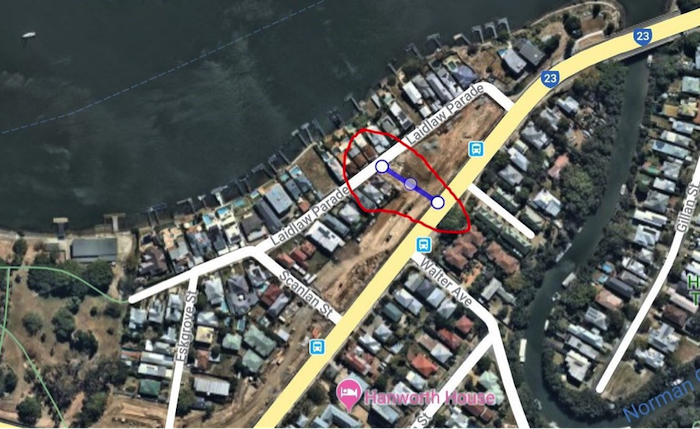Laidlaw Parade, East Brisbane.
Part 1 – The beginning
There were many private hospitals in and around Brisbane in the late 1920s to the early 1960s. These were usually run by individuals such as matrons, doctors, nurses or a combination. As there was only one public hospital in Brisbane at the time (Brisbane General Hospital) the private hospitals played an important role in supplying medical care, especially maternity care, in smaller, local facilities.
Standards varied greatly depending on the qualifications of those who ran them. There was no State control over private hospitals until the Health Act 1911 provided for licensing by local authorities.

The history of Berilda Private Hospital is typical of others of its era. It was opened in 1933 by Julia Shepherd Waller, a nurse, experienced matron and daughter of a North Queensland sugar plantation pioneer. The family moved to Brisbane in 1916 and lived in Norman Park, then a developing middle class suburb.
Julia, aged 25, went to Sydney and after completing nursing training worked in several locations in Qld and NSW. She set up her own private hospital in Kensington around 1930. Two years later she returned to Brisbane to establish another hospital. Her decision was partly influenced by her father’s declining health. He had been admitted to her hospital in Sydney in 1931, so when she returned to Brisbane she looked for a site near her parents’ home. She chose East Brisbane as it was considered a quiet, well-regarded residential suburb near the river, close to public transport with trams on nearby Lytton Road.
She bought Chorlton, a large timber residence at 40 Laidlaw Parade, built in the late 1910s on land which was once part of the Eskgrove Estate. Eskgrove, now heritage-listed, is one of Brisbane’s oldest homes. Some of Brisbane’s wealthiest residents lived on Laidlaw Parade. It also ended in Mowbray Park, providing a pleasant outlook for the sick. Another plus was Hanworth House, nearly opposite Chorlton across Lytton Road, which was then being run as a hospice.

The hospital was opened in 1933 and was named ‘Berilda’, possibly inspired by the well-established Burilda Private Hospital in New South Wales, but with slightly different spelling.
New council ordinances issued in 1929 had set up three classes of private hospital – general, surgical only and maternity only. Berilda was a ‘Class A’ hospital, ‘a general private hospital for the reception, care and treatment of medical, surgical and maternity cases’. Doctors referred their patients to the hospital, and operated and treated them on the premises. At one point eighteen or nineteen doctors had patients staying in Berilda. Matron Waller lived on site and provided full time care, and extra nurses were employed to comply with the rule of one nurse for every three occupied beds.
The first patients were family members, including her father Edwin who sadly died at the hospital in 1935. Other patients reflected the make-up of the suburb: a mix of wealthy, famous and middle class.
On 30 March 1933 the first baby was born in Berilda. Matron Waller wanted her to be named Berilda after the hospital, but the mother declined and called her Beryl. Many current southside residents were born at the hospital.
(Thank you to Claire Stewart for allowing me to summarise the paper which she presented to the Brisbane History Group on May 2016)
Part 2: Berilda and the challenging 1930s
The late 1930s were challenging times for private hospitals with changing standards in medical care. Major concerns raised by doctors and politicians focussed on quality, especially the quality of the buildings, as most, like Berilda, were not purpose-built hospitals.
In 1937 the State Government took over control of private hospitals from local governments and introduced stringent new standards under amendments to the Health Act. Hospitals which did not comply were closed down. Between 1937and 1939 sixty private hospitals were closed down [from 215 in 1937 to 155 in 1939].
While most of these changes did not have a great affect on Berilda, a parliamentary proposal to shut down all hospitals housed in old timber buildings did cause concern. Fortunately for Berilda and other timber hospitals this proposal did not become law, but changes such as fireproofing the old buildings did have to be made.

The heritage-listed Turrawan Private Hospital, Clayfield, built in 1932, was designed by prominent Brisbane architect Eric Percival Trewern. He also designed the improvements for the Berilda Private Hospital in 1937. After closing in 2003 the hospital was bought by neighbouring Clayfield College, refurbished in 2006 and is now a beautiful Boarding House for 120 boarders. (Photo: BCC Local Heritage Register.
Julia Waller was quick to act as she realised that Berilda could no longer continue to function the way it was. In December 1937 she engaged well-known Brisbane architect Eric Percival Trewern to design alterations and improvements to Berilda. He had also designed the Turrawan Private Hospital in Clayfield (1932-2003) which is now heritage-listed and a Boarding House for Clayfield College; he later also designed other hospitals for the government.
A major change for Berilda came when Matron Waller left in 1939. The new owner, Matron Collis, had a completely different approach and began to widely advertise the hospital. Many private hospitals closed during the Second World War, mostly due to a lack of nursing staff, who were serving overseas or were seconded to public hospitals. Despite difficulties in getting ward and kitchen staff, Berilda somehow managed to stay open and a large number of babies was born there between 1939 and 1945.

Another change in matron occurred in November 1946 when Elaine Jones took over. She had had seven years experience with Baby Clinics and her sister provided general nursing care, allowing Berilda to continue as a general hospital. However, Matron Jones’s time at the hospital coincided with Berilda’s most notorious years.
 In 1947 reports of two deaths at Berilda caused sensations. One was the death of a mother in childbirth, the second, that of a baby seven days after her birth. Inquests into both deaths cleared the hospital of any wrongdoing.
In 1947 reports of two deaths at Berilda caused sensations. One was the death of a mother in childbirth, the second, that of a baby seven days after her birth. Inquests into both deaths cleared the hospital of any wrongdoing.

Five years later the death of a 57-year-old man provided the hospital with more bad publicity. Allegations that the death had been due to the patient being left unattended after surgery were not upheld, but Matron Jones and Sister Shirley McFarland refused to take the stand, and their photos were printed in the Truth newspaper, amongst others. Later in the year the widow issued a writ against Matron Jones, her sister Phyllis Jones and the hospital for £4,250. She apparently dropped the case, but Berilda’s reputation had definitely changed.
(Sources: Geraint Gregory’s research files; paper presented by Claire Stewart to the Brisbane History Group, May 2016); Trove
Part 3: More challenges and problems lead to the end of an era
Among the many doctors who worked at Berilda two names stand out: Atkinson and Cilento. Dr Leigh Atkinson, father-in-law of former Lord Mayor of Brisbane, Sallyanne Atkinson, worked at Berilda as consultant and operated there. The family used to live in what is now the East Brisbane Community Centre at 538 Vulture Street East. Lady Cilento (Phyllis Dorothy Cilento) and Sir Raphael Cilento also practised at Berilda for a time and one of their children, Diane Cilento, had a child there.
While private hospitals originally filled a gap when there was only one public hospital, this began to change with improvements in Queensland public hospitals from the late 1930s. The 300-bed Brisbane Women’s Hospital was opened in 1939 and provided cheap quality care with a major focus on maternity services. The Brisbane General Hospital was also improved and expanded at the time. In 1946 Queensland was the first state in Australia to introduce free public hospital treatment. Ten years later, in 1956, the opening of the Princess Alexandria Hospital gave southside residents easy access to free hospitals and therefore reduced the pressure on other hospitals.
With all these changes to the public health and hospital system, private hospitals struggled to exist with increasing costs and demanding legislative changes. Despite raising fees many could not stay viable and started to close. Although the Government introduced subsidies for patients of private hospitals, these measures helped only a little. Churches started to take over some of the private hospitals, while others simply closed. Numbers of private hospitals operating in Brisbane began to reduce rapidly: from 52 in 1937, 22 in 1953, 20 in 1958 and only 12 in 1960.
Berilda managed to continue for a few more years under yet another new matron. Matron Deignon took over in 1953 after having resigned the previous year from the Maryborough Base Hospital in controversial circumstances. Like Matron Jones, she brought her sister with her to provide additional nursing care. But the sisters were only at Berilda for a few years before they moved to New Farm.

Berilda Private Hospital finally closed in 1958 and the building was converted into flats in 1959. It was demolished in 2004 and a new three-storey private home was built on the site. This home and many others in the area were demolished in 2018 as part of the Lytton Road Widening Project – finally erasing all physical trace of the Berilda Private Hospital.

As part of the road widening project a new short, 50m long street running between Laidlaw Parade and Lytton Road will be created (see photo). When the local Councillor for The Gabba Ward, Cr Jonathan Sri, asked for suggestions for a name for this new street, Berilda Street was one of the suggestions – others were Bottleneck Street, Humbug Street, Kulpurum Street and Riversdale Street – all with local historic merit. The winning name was Kulpurum, which is the Aboriginal word for Norman Park.
It seems a pity that this opportunity to keep the name Berilda alive in the local area and thereby acknowledge its significant contribution to healthcare in challenging times was missed. Hopefully those who had direct contact with the hospital will help to keep its memory alive and perhaps work towards installation of a plaque so that this local history is not forgotten.
(Sources: thank you to Geraint Gregory for his research materials; Claire Smith for her paper on Berilda; Trove article; BCC notes)
